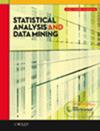具有 L1/2 正则化的贝叶斯相对复合量回归方法的序潜回归模型
IF 2.1
4区 数学
Q3 COMPUTER SCIENCE, ARTIFICIAL INTELLIGENCE
引用次数: 0
摘要
序数数据经常出现在知识水平评估、信用评级、临床疾病诊断和心理评估等各个领域。包括累积逻辑回归或概率回归在内的经典模型经常被用于对此类序数数据建模。但这些建模方法将响应变量的平均特征有条件地刻画在一组预测变量上,这往往会导致不可靠的估计结果。作为一种重要的替代方法,复合量化回归(CQR)方法通常被用来获得更稳健和相对高效的结果。本文提出了一种针对序潜回模型的贝叶斯 CQR 建模方法。为了克服所考虑模型的可识别性问题并获得更稳健的估计结果,我们主张使用贝叶斯相对 CQR 方法来估计回归参数。此外,在回归建模中,获得一个只保留重要协变量的简约模型是一项非常理想的任务。我们将贝叶斯 L1/2$$ {L}_{1/2} $$ 惩罚纳入序潜伏 CQR 回归模型,以同时进行参数估计和变量选择。最后,通过蒙特卡罗模拟和实际数据应用说明了所提出的贝叶斯相对 CQR 方法。仿真结果和真实数据实例表明,建议的贝叶斯相对 CQR 方法在序数回归模型中具有良好的性能。本文章由计算机程序翻译,如有差异,请以英文原文为准。
Bayesian relative composite quantile regression approach of ordinal latent regression model with L1/2 regularization
Ordinal data frequently occur in various fields such as knowledge level assessment, credit rating, clinical disease diagnosis, and psychological evaluation. The classic models including cumulative logistic regression or probit regression are often used to model such ordinal data. But these modeling approaches conditionally depict the mean characteristic of response variable on a cluster of predictive variables, which often results in non-robust estimation results. As a considerable alternative, composite quantile regression (CQR) approach is usually employed to gain more robust and relatively efficient results. In this paper, we propose a Bayesian CQR modeling approach for ordinal latent regression model. In order to overcome the recognizability problem of the considered model and obtain more robust estimation results, we advocate to using the Bayesian relative CQR approach to estimate regression parameters. Additionally, in regression modeling, it is a highly desirable task to obtain a parsimonious model that retains only important covariates. We incorporate the Bayesian penalty into the ordinal latent CQR regression model to simultaneously conduct parameter estimation and variable selection. Finally, the proposed Bayesian relative CQR approach is illustrated by Monte Carlo simulations and a real data application. Simulation results and real data examples show that the suggested Bayesian relative CQR approach has good performance for the ordinal regression models.
求助全文
通过发布文献求助,成功后即可免费获取论文全文。
去求助
来源期刊

Statistical Analysis and Data Mining
COMPUTER SCIENCE, ARTIFICIAL INTELLIGENCEC-COMPUTER SCIENCE, INTERDISCIPLINARY APPLICATIONS
CiteScore
3.20
自引率
7.70%
发文量
43
期刊介绍:
Statistical Analysis and Data Mining addresses the broad area of data analysis, including statistical approaches, machine learning, data mining, and applications. Topics include statistical and computational approaches for analyzing massive and complex datasets, novel statistical and/or machine learning methods and theory, and state-of-the-art applications with high impact. Of special interest are articles that describe innovative analytical techniques, and discuss their application to real problems, in such a way that they are accessible and beneficial to domain experts across science, engineering, and commerce.
The focus of the journal is on papers which satisfy one or more of the following criteria:
Solve data analysis problems associated with massive, complex datasets
Develop innovative statistical approaches, machine learning algorithms, or methods integrating ideas across disciplines, e.g., statistics, computer science, electrical engineering, operation research.
Formulate and solve high-impact real-world problems which challenge existing paradigms via new statistical and/or computational models
Provide survey to prominent research topics.
 求助内容:
求助内容: 应助结果提醒方式:
应助结果提醒方式:


